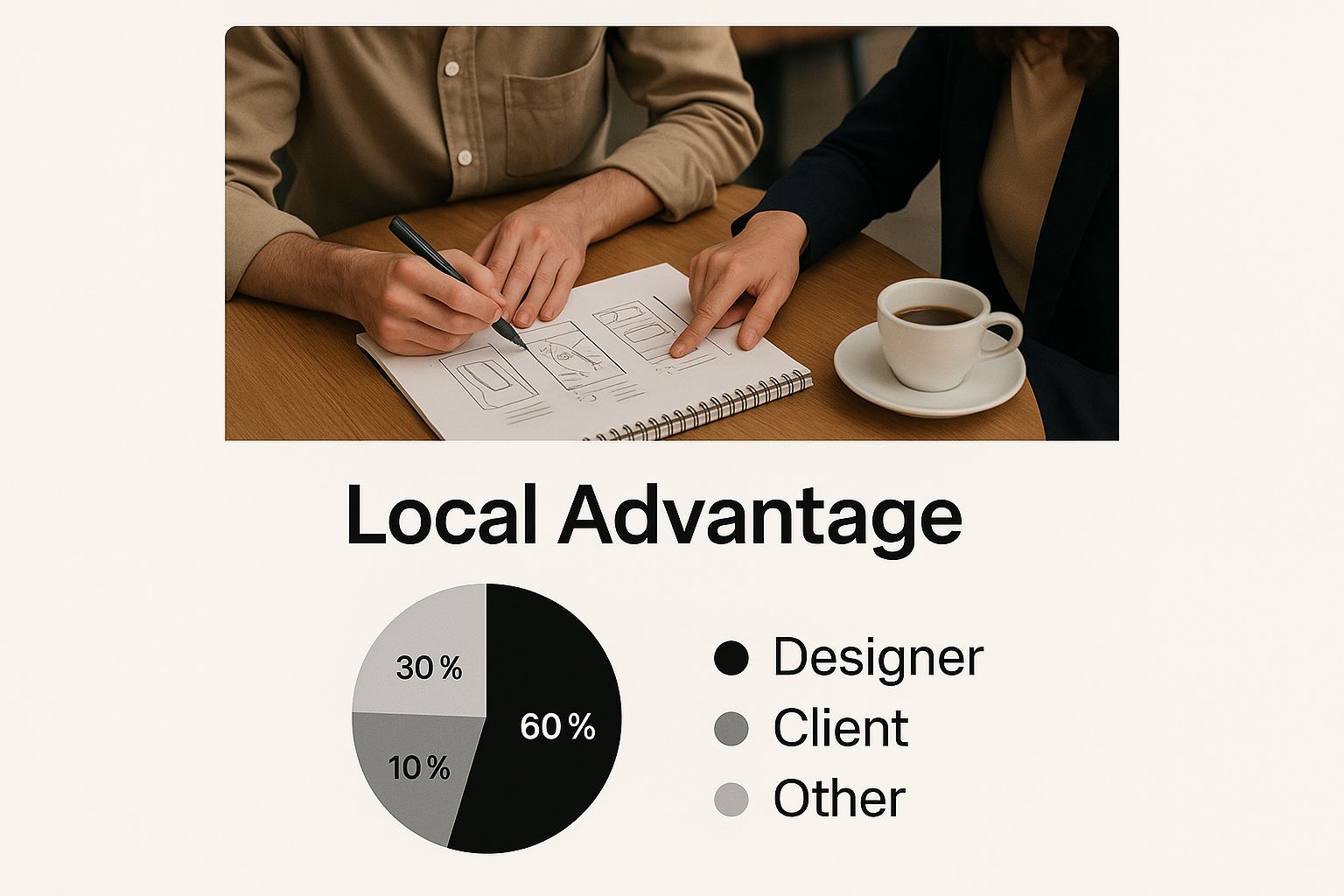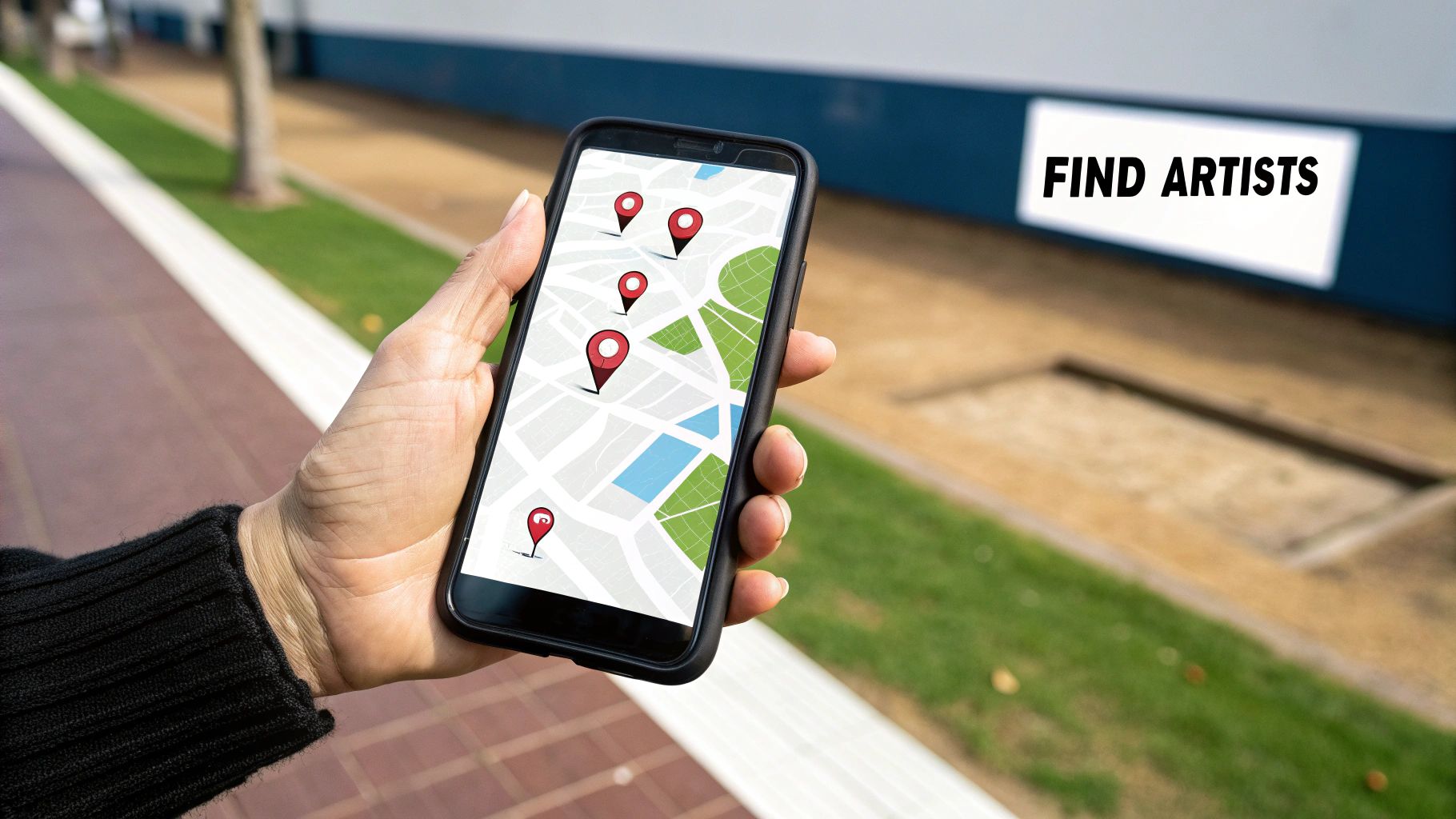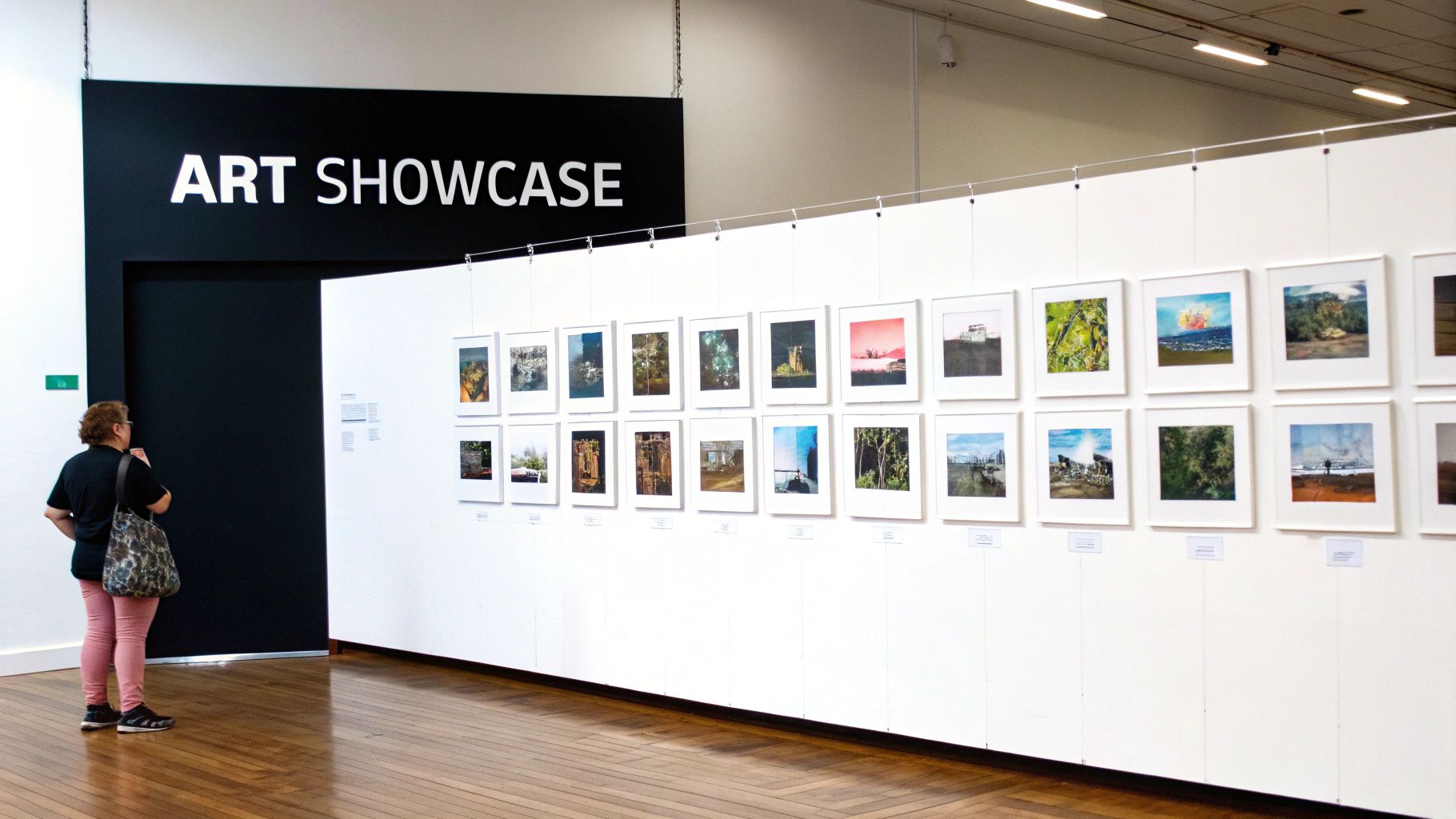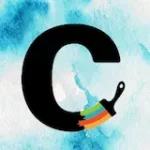Before you even think about searching for local graphic artists, you need to do some homework. The first, most critical step is figuring out exactly what you need. This isn't just busywork—it's the foundation that prevents expensive misunderstandings and ensures you find the right person for the job.
Get Your Ducks in a Row Before You Start the Hunt
Jumping into a search for a designer without a clear plan is like walking into a grocery store hungry and without a list. You’ll end up with a cart full of stuff you don’t need and forget the milk. The absolute cornerstone of a great creative partnership is a solid project brief. This is where you turn all those vague ideas floating around in your head into something a designer can actually work with.
Think about it. Are you a brand-new startup that needs an entire visual identity built from scratch? Or are you an established company just looking for some slick social media graphics for a new product launch? These are two wildly different projects, each demanding a unique skill set, timeline, and budget.
What Do You Actually Need?
Start by jotting down the essentials. You don't need to know all the fancy design lingo; just be clear about your goals. A good brief should cover:
- Project Goals: What's the point of all this? Are you trying to boost sales, get more eyeballs on your brand, or maybe launch a new service? Be specific.
- Target Audience: Who are you talking to? A design that works for Gen Z won't fly with a room full of corporate lawyers.
- Specific Deliverables: Make a literal list of what you need. A new logo? A set of web banners? A brochure layout? Packaging design? Write it all down.
- Brand Personality: If your brand were a person, who would it be? Try to describe it in a few words, like "bold, professional, innovative" or "friendly, organic, trustworthy."
Walking into a conversation with an artist armed with this information makes everything a million times more efficient. And to keep things running like a well-oiled machine, it's always smart to brush up on project management strategies for designers.
Let's Talk Money and Deadlines
Your budget and timeline are the two biggest filters in your search. Don’t be shy about what you can afford. Being upfront about your budget respects everyone's time and quickly weeds out candidates who aren't a financial fit.
A well-defined budget isn't just about limiting costs; it's about communicating value. It tells a potential designer that you've thought through the project and are serious about investing in quality work.
The same goes for your timeline. Map out the key milestones. When do you need to see the first round of concepts? When is the final, drop-dead deadline? Always, always build in a buffer for feedback and revisions. Trust me on this. For a more detailed guide, check out our post on how to write a design brief.
The need for skilled designers isn't slowing down. As the economy grows, businesses invest more heavily in promotion, which directly fuels the graphic design market. In fact, between 2020 and 2025, industry revenue grew at an annual rate of about 4%, hitting an estimated market size of $55.7 billion. You can dig into more data over at the global graphic design industry from IBISWorld.
Finding the Right Local Graphic Artist For Your Project
Alright, you've got your project brief nailed down. Now for the fun part: finding the perfect creative to bring it to life. A quick Google search is one way to go, but if you want to find the best local graphic artists, you'll need to dig a bit deeper. Casting a wide net, both online and in your own community, is the key to building a strong pool of candidates.
Working with someone local brings a ton of unique advantages, from a shared cultural context to the simple-but-powerful ability to collaborate in person.

Honestly, nothing beats sitting down face-to-face to hash out a complex project. That direct connection helps ensure your brand’s message really hits home with the local audience, often making the whole design process feel more intuitive and effective.
Tap Into Your Local Community Hubs
Don't sleep on the resources in your own backyard. Your community is probably buzzing with skilled professionals who already get the local business scene. You just need to know where to look.
Here are a few spots I always recommend checking out first:
- Your Local Chamber of Commerce: This is a goldmine for networking. Pop into one of their mixers or just browse the member directory. You'll likely find a handful of design agencies and freelancers right away.
- Creative Industry Meetups: Fire up sites like Meetup or Eventbrite and search for events geared toward designers, marketers, and other creatives. These are fantastic places to meet talented people in a more relaxed setting.
- University Art Departments: Get in touch with the career services office at a nearby college. They're often happy to pass along job postings to sharp final-year students and recent grads who are eager to make their mark.
These real-world connections give you a much better feel for an artist’s personality and professionalism—two things that are crucial for a great partnership but hard to gauge from a screen.
Tapping into local networks does more than just find you a designer; it integrates your project into the local creative ecosystem. A well-connected local artist often has relationships with the best printers, photographers, and copywriters in town.
Master the Art of the Local Online Search
While nothing beats a personal connection, online platforms offer incredible efficiency and a direct line to massive portfolios. The trick is to get strategic with your search filters to zero in on artists in your specific area.
There are several avenues to explore, each with its own vibe and set of tools. Here's a quick rundown of where I've had the most success finding local talent.
Comparing Platforms to Find Local Artists
A look at different online and offline methods for finding local graphic artists, highlighting their unique strengths and best use cases for your business.
| Method | Best For | Pros | Cons |
|---|---|---|---|
| Portfolio Sites (Behance, Dribbble) | Browsing high-quality, curated work from established professionals. | Excellent visual search; location filters; clear showcase of skills and style. | Can be competitive; top talent might be busy or have higher rates. |
| Social Media (Instagram, LinkedIn) | Discovering emerging talent and getting a feel for a designer's personality. | Real-time updates; easy to see their network and engagement; direct messaging. | Portfolios can be less formal; quality varies widely. |
| Local Community Groups (Facebook) | Getting trusted recommendations from other local business owners. | Vetted talent; find artists who are actively seeking local work. | Can be hit-or-miss depending on the group's activity level. |
| In-Person Networking (Meetups) | Making genuine connections and assessing professionalism face-to-face. | Builds strong relationships; can lead to valuable referrals for other services. | More time-consuming; limited by who shows up to a specific event. |
Platforms like Behance and Dribbble are the industry standard for a reason. Use their location filters to narrow your search down to your city or state. It’s the fastest way to browse top-tier portfolios from pros who are genuinely in your area.
Social media can also be a surprisingly effective tool. Try searching hashtags like #DenverDesigner or #ChicagoCreative on Instagram and LinkedIn. Many artists use these platforms as living portfolios. You can also find dedicated local creative groups on Facebook where businesses post gigs and artists share their latest work. These communities are fantastic for getting recommendations from other local business owners. For a deeper dive, our guide on how to find graphic designers has even more strategies.
By mixing and matching these search methods, you’ll build a much more diverse and solid list of potential hires. This multi-channel approach helps ensure you don't just find any designer, but the right local graphic artist for your project.
How to Look at a Design Portfolio the Right Way

It’s easy to get wowed by a slick portfolio. But a great portfolio does more than just show off pretty pictures—it tells a story of real-world problem-solving. Your job is to peel back the layers and look for proof that a designer can actually deliver results for you.
So, you need a game plan. Don't just scroll endlessly. You’re on a mission to check for three key things: stylistic range, consistent quality, and a direct connection to your business goals. A portfolio packed with passion projects is cool, but one that highlights successful client work? That’s the sweet spot.
Look for Range and Versatility
First up, check out the artist’s range. A designer who has mastered a single, niche style might be perfect for a one-off project. But what happens when your brand evolves? You're looking for a creative partner who can adapt, not a one-trick pony.
Keep an eye out for these signs of true versatility:
- Different Kinds of Clients: Have they worked with serious corporate brands and playful startups? Seeing that mix proves they can dial in different brand personalities.
- A Variety of Projects: A strong portfolio is more than just a wall of logos. Look for web graphics, print materials, social media campaigns, or even packaging design. This shows you the true breadth of their skillset.
- Multiple Artistic Styles: Can they nail a clean, minimalist vibe just as well as something more detailed and illustrative? That kind of flexibility is a massive plus.
Spotting this kind of range tells you you’re dealing with one of the more capable local graphic artists who can stick with you for the long haul. A designer who can think strategically is an invaluable asset. And if you're a designer looking to level up your own presentation, our guide on portfolio presentation tips is a great place to start.
Analyze the Story Behind the Work
Here's the thing: great design doesn't just look good; it solves a problem. The absolute best portfolios include case studies or short blurbs explaining the "why" behind each project. This is where you separate the artists from the strategic designers.
As you look through their work, ask these questions:
- What was the client trying to achieve? A pro designer will set the stage. Were they trying to boost sales, rebrand for a new audience, or launch a product?
- How did the design solve that problem? Look for a peek into their process. Why that color palette? Why that font?
- What were the results? The top-tier portfolios often mention real outcomes, like a 25% increase in user engagement or a flood of positive customer feedback.
A portfolio without context is just an art gallery. A portfolio with context is a collection of business solutions. You’re not just hiring for artistic skill; you’re hiring for someone who can turn your business needs into a visual strategy that actually works.
This isn't just about finding a hobbyist with a cool Instagram feed. You're investing in a critical business service. The global graphic design industry is a huge economic driver, with a market size valued at around $43.4 billion as of 2025—making it the 9th-largest global business activity.
The industry has bounced back strong since the pandemic, proving its resilience. You can dig into more of these graphic design statistics on Colorlib. Knowing this helps frame your search: you’re looking for a professional who can deliver a tangible return, and by carefully evaluating their past work, you can find a local graphic artist who is exactly that.
Asking the Right Questions in an Interview

Alright, you've sifted through a mountain of portfolios and found a few designers who really stand out. Now for the important part: moving past the pixels to see if they’re the right fit for your team and your project.
The interview is your shot to understand how an artist thinks, communicates, and handles the inevitable bumps in the road. This conversation needs to go way beyond just talking about their rates. You're looking for a creative partner, and your questions should dig into that.
Probing Their Creative and Strategic Process
Let's get into how they actually approach their work. A great designer does more than just make things look pretty; they use visuals to solve real business problems. You need to know if they think strategically and if that thinking lines up with your goals.
Here are a few questions I always like to start with:
- "Walk me through your process for turning a project brief into a final design. What are the key milestones?" This question is gold. It instantly shows you how organized they are and whether their workflow is built around the client's needs.
- "Can you describe a time when a client gave you vague or challenging feedback? How did you handle it?" This is all about testing their people skills and how they navigate tricky situations without getting flustered.
- "Which project in your portfolio are you most proud of, and what specific problem did it solve for the client?" This lets them show off a bit, but more importantly, it connects their design work to tangible, bottom-line results.
The best local graphic artists are excellent communicators. Their ability to ask clarifying questions, interpret feedback, and explain their design choices is just as important as their technical skill with Adobe Illustrator.
These kinds of questions shift the conversation from what they create to how they create it. Finding a local graphic artist who’s a master of both is how you build a killer partnership. If you need more ideas, checking out some common https://creativize.net/blog/interview-questions-for-graphic-designers can help you prepare.
Understanding Their Professionalism and Work Style
Creative talent is crucial, but you also need someone who's reliable and professional. These next questions are about gauging how they handle the business side of design—the stuff that keeps your project on schedule and on budget.
Especially with remote work being the norm, understanding their process is key. You can explore these essential video interview questions for 2025 to get more dialed in on virtual hiring.
I always make a point to ask about their day-to-day work habits:
- How do you prefer to get feedback—in an email, on a call, or through a platform like Frame.io?
- What project management tools are you comfortable with? Trello, Asana, Monday.com?
- What’s your standard approach to revisions, and how do you handle requests that creep beyond the original scope?
The answers here paint a clear picture of what it will actually be like to work with them. Remember, you’re not just hiring a portfolio; you’re bringing a person onto your team. Making sure your work styles mesh is the final piece of the puzzle.
You’ve done it. You’ve sifted through portfolios, had some great conversations, and finally found the perfect local graphic artist for your project. That’s a huge win, but hold off on the victory lap for just a minute. There’s one last, crucial step: putting everything in writing with a solid, professional contract.
A handshake is nice, but it’s a terrible project manager. Verbal agreements are a breeding ground for confusion and unmet expectations. A good contract, on the other hand, is your project’s instruction manual. It’s there to protect both you and your designer by making sure everyone is on the same page from day one.
What Goes Into a Strong Design Contract?
Think of your contract as a roadmap for your entire collaboration. It's your chance to ask and answer all the important questions before they turn into problems. A vague agreement is a surefire recipe for scope creep, blown deadlines, and going way over budget.
Your agreement should always cover these bases:
- A Super-Detailed Scope of Work: Don’t just say “a new logo.” Get specific. How many variations are included (e.g., full color, black and white, an icon-only version)? What file formats will you get (.JPG, .PNG, .SVG)? Will it include matching designs for business cards or social media banners? Spell it out.
- Clear Deliverables and Deadlines: Make a list of every single thing you expect to receive. Then, attach a realistic due date to each item. This creates a shared timeline that keeps the project on track.
- Revision Rounds: This one is huge. Define exactly how many rounds of revisions are included in the quoted price. Two or three rounds is pretty standard. Anything more than that should be billed at an hourly rate you both agree on upfront.
A well-drafted contract isn't about mistrust—it's about mutual respect. It shows you value the designer's time and expertise and are serious about building a professional, organized partnership.
Talking Money and Who Owns What
The money talk can feel a little awkward, but it's way more awkward to deal with a payment dispute halfway through a project. Getting the financial details in writing is non-negotiable.
Did you know that 90% of the graphic design market is made up of freelancers? Freelancing is the dominant way local graphic artists work. Their hourly rates can swing wildly, from $20 to over $150, all depending on their experience and where they’re based. You can dig into more graphic design statistics on Exploding Topics if you're curious.
Your contract needs to be crystal clear about the payment structure. Is it a fixed project fee or an hourly rate? A fixed fee makes sense for a defined project like a new brand identity. Hourly is better for ongoing work or projects where the scope might evolve.
Also, lock down the payment schedule. A 50% upfront deposit and 50% upon completion is a common practice that gives both sides security.
Finally, tackle intellectual property. The contract must state that once the final payment is made, you (the client) own the rights to the final, approved artwork. It’s also smart to clarify if this includes the original source files (like .ai or .psd files). Sometimes these require an extra buyout fee.
Nailing down all these details from the start is the key to a smooth and successful project. For a deeper dive, check out our detailed guide on putting together a graphic design agreement.
Got Questions About Hiring a Local Designer? We've Got Answers.
Jumping into the hiring process for a creative pro can feel a little intimidating. You’ve got questions, and getting solid answers is the key to moving forward with confidence and dodging those rookie mistakes that can sink a project.
Here’s a breakdown of the common uncertainties we see business owners grapple with when they start looking for local graphic artists.
How Much Should I Budget for a Local Graphic Artist?
This is always the million-dollar question, isn't it? The honest answer is: it really depends. The cost of a graphic artist can swing wildly based on their experience, how complex your project is, and what the going rate is in your city.
A simple logo might set you back a few hundred dollars, but if you’re looking for a full-blown brand identity package, you could be looking at a bill in the thousands.
Your best move? Reach out and get detailed quotes from at least three different designers you’re seriously considering. This will give you a real-world baseline for what your specific project should cost in your area. If a bid seems too good to be true, it probably is. That super-low price might reflect a lack of professional experience or a major misread of what your project actually involves.
What Are the Real Benefits of Hiring Locally?
In a world overflowing with remote talent, why bother looking for someone in your own backyard? The perks are often more tangible than you’d think. Hiring local graphic artists means you can actually meet up in person, which can be an absolute game-changer for brainstorming sessions and nailing down complex brand strategies.
A local designer brings more than just creative skill; they bring community context. They get the local market, the audience's quirks, and the regional business vibe in a way an outsider just can't.
Plus, they usually have a trusted network of local pros they can recommend—think printers, photographers, and web developers. While the global talent pool is huge, a local professional offers a more personal, tuned-in partnership that often leads to more powerful work.
How Many Revisions Are Standard for a Design Project?
This is one of those details you absolutely have to iron out from the get-go to keep your project on track and on budget.
Most professional graphic artists will include two or three rounds of revisions in their standard project fee. This isn't arbitrary; it’s structured to encourage you to give clear, consolidated feedback instead of sending a constant trickle of tiny tweaks.
Make sure the number of included revisions is spelled out clearly in your contract. Any changes you ask for beyond that agreed-upon limit will typically be billed at the designer’s hourly rate. The trick to avoiding extra costs is to provide thoughtful, comprehensive feedback during each round.
Who Owns the Final Artwork and Source Files?
Understanding ownership is crucial for protecting your brand for the long haul. Typically, once you’ve paid the final invoice, you—the client—own the rights to use the final, approved artwork for its intended purpose.
But here’s the catch: the designer usually retains ownership of all the early concepts and the original, editable source files (like the Adobe Illustrator or Photoshop files). If you want those, you’ll likely need to negotiate a full buyout, which often comes with an extra fee.
Your contract needs to be crystal clear about who owns what and which specific file formats you’ll receive when the project wraps up.
Ready to connect with top-tier creative professionals right in your area? On Creativize, you can browse detailed portfolios and find the perfect local talent to bring your vision to life. Find your next creative partner on Creativize.

